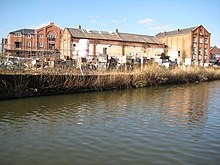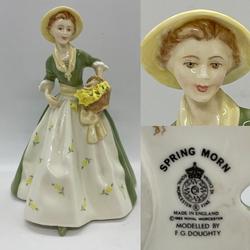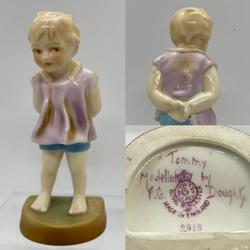Royal Worcester
The history of Royal Worcester is a tale of fine porcelain craftsmanship and innovation that spans over two centuries. Royal Worcester is a British porcelain company that has established a reputation for producing some of the world’s finest and most beautiful porcelain pieces.
Porcelain was once a luxury item exclusive to China. Production began in Germany in 1711 (Meissen) and in the early 18th century in Italy and France. Fifty years later it was manufactured in England.
The Worcester Tonquin Manufacture was formed in June 1751 when a group of 14 local businessmen, led by Dr John Wall, established a porcelain factory in the city of Worcester England. Their aim was to produce porcelain wares that rivalled those of the established porcelain manufacturers in Europe, particularly the Chinese and Meissen porcelain.
The newly formed company leased their first premises, Warmstry House, on the Severn in Worcester. They began making tableware and teapots.

Site of Worcester Porcelain Works
The early years of the Worcester factory were challenging, with the production process and techniques requiring refinement. However, in 1756 the factory introduced a breakthrough innovation – the creation of a porcelain body that closely resembled the quality and appearance of Chinese porcelain. This development helped the company gain recognition and set a foundation for its future success.

Tea Canister, (1768) in the V&A Museum
Dr Wall retired in 1774, and died in 1776. Wiliam Davis was head of the factory until his death in 1783 when their London agent, Thomas Flight, purchased the company.
Thomas Flight let his two sons run the concern, with John Flight taking the lead role until his death in 1791.
Soft-paste armorial porcelain plate with the coat of arms of the Duke of Clarence (1789)
The Worcester Porcelain Company concentrated on quality table ware; however, they did make a handful of unsophisticated figurines in their early years.
In 1789, following a visit to the factory by King George III and Queen Charlotte, the King granted the factory a Royal Warrant and the company became known as the "Royal Porcelain Works."
The company’s reputation soared in the Victorian era when the company introduced its iconic “blush ivory” porcelain. This delicate and highly sought-after porcelain featured a soft, translucent ivory colour and often showcased intricate hand-painted designs. The blush ivory pieces, including vases, plates and figurines, became synonymous with Royal Worcester’s craftsmanship and were highly prized by collectors and enthusiasts.
An 1891 Royal Worcester Blush Ivory Vase
The following years the factory fell into disrepair. Production was limited to low-end patterns of mostly blue and white porcelains after Chinese designs of the period. It was also pressured by competition from inexpensive Chinese export porcelain, and from Thomas Turner’s Caughley Factory.
Martin Barr joined the firm as a partner in 1792; porcelains of this period are often identified by an incised capital "B" and, later, by more elaborate printed and impressed marks.
Thomas Flight died in 1800 and he left the factory in the hands of his son, Joseph Flight and Martin Barr. Martin Barr had two sons that were being trained to run the factory.
In addition to the warrant granted by King George III, royal warrants were also issued by The Prince of Wales in 1807 and the Princess of Wales in 1808.
In the 1840s there was a merger with Chamberlain’s Factory and the operation was then moved to Diglis, the site of the Chamberlain’s works, where the present factory stands.
After an extensive fire at the factory in the early 1850s, the rebuilding was overseen by the new owners, Richard William Binns and William Henry Kerr. Modern machinery was purchased and installed and new working methods improved the quality of the product.
Richard Binns and William Kerr introduced Parian, a semi-matte material high in feldspar, (first used by the Copeland factory in the 1840). This material was more lasting and easily coloured or gilded making it more suitable for detailed modelling with which the name Worcester is now synonymous.
This led to an expansion in both the production and demand for figurines. The Worcester Royal Porcelain Company Limited was formed in 1862 after William Kerr retired.
RW3546 – Spring Morn Modelled by Freda Doughty
The company started hiring trained sculptors to do their modelling, in the 1870s James Hadley produced the greatest number and variety of Worcester models. James Hadley left Worcester in 1876 and in 1896 he formed his own business with his sons. Two years after his death in 1903, his business was acquired by the Worcester Royal Porcelain Company, who had also bought their other major competitor in the city, the Grainger factory in 1889.
The company entered into a period of crisis from 1900 to the First World War.
During the war the Worcester factory produced delicate porcelain figures in a style reminiscent of German crinolines in an attempt to substitute British for German crafts. Frederick M Gertner worked on these figures as well as the ‘Historical and Regimental’ series which was introduced at this time.

A number of birds and small nude figures were made in Crownware, which was a high fired earthenware and was much cheaper to produce than the Parian. Unfortunately, this was an unsuccessful move for the Worcester factory and despite trying to produce powder bowls, ashtrays, various jugs and Tobies, there was very little demand for luxury china. Royal Worcester escaped closure when it was rescued by Charles Dyson Perrins.
In 1931 all forms of earthenware and glazed Parian were discontinued and under the guidance of the Managing Director, Joseph Gimson a new range of bone china figures were launched.
At first, only the models of children by Freda Doughty were popular, the designs from other freelance modellers failed to sell.
RW2913 - Tommy by Freda Doughty
Royal Worcester was encouraged to make Limited Edition bird models, Dorothy Doughty designed birds for the American market from her studio in Cornwall, which she shared with her sister, Freda. Dorothy had never worked in clay before, but was determined to make the birds as life-like as possible.
Dorothy Doughty
Special matt colours were developed and new skills in mould making, casting and propping were needed to make such complex models in bone china. Towards the end of her life Dorothy also designed a series of English birds and a set of collectors’ plates which were modelled in relief.
RW3532 Ovenbird with Lady’s Slipper by Dorothy Doughty
During World War II, one third of the Royal Worcester factory was turned over to the Ministry of Aircraft and from 1941 insulators were made for radio and radar equipment. A high fired, heat and shock resistant porcelain had been developed at the request of the government. This production of the porcelain continued throughout the second world war.
This hard porcelain was also used to make ‘fireproof’ cookware from the 1930s onwards including gold and silver lustre wares which were introduced after the war.
Royal Worcester opened a showroom in 1948 in Mayfair and many successful series of small decorative figures were introduced, including British Birds by Eva Soper. Oriental Figures by Agnes Pinder Dabis and Animal Studies by Doris Lindner.
Some of the company’s most successful modellers were Stella Crofts, Dorothy and Freda Doughty, Doris Lindner, Eva Soper and Pheobe Stabler. John Bromley, Peter Holland and Amanda Hughes-Lubeck also modelled items for Royal Worcester.
RW4921 – Punch by Amanda Hughes-Lubeck
In 1976, Royal Worcester merged with Spode, another esteemed British porcelain manufacturer. The merger created a company known as Royal Worcester and Spode Limited, preserving the legacy of both brands.
After the merger with Spode and due to competition from overseas, the production ceased in Worcester and the bulk of porcelain and bone china was made under contract abroad. The business in Worcester city was concentrated into a smaller area and talented artists continued to hand paint and gild bespoke items.
Sadly, the last trading date for Royal Worcester was 14 June 2009.
However, the Royal Worcester brand and its heritage were not entirely lost. In 2013, the brand was revived by Portmeirion Pottery Group. As the Portmeirion Group has a factory in Stoke-on-Trent, the purchase did not include the Royal Worcester and Spode manufacturing facility.
Portmeirion continues to produce and market Royal Worcester porcelain, paying homage to its rich history while introducing new designs and collections.
Royal Worcester porcelain is cherished for its timeless beauty and exquisite craftsmanship. The company’s pieces, both vintage and contemporary, continue to be highly sought after by collectors around the world, cementing Royal Worcester’s place as one of the most esteemed names in the porcelain industry.
RW4778 – Anniversary of the Year Figurine 2000 – by John Bromley









